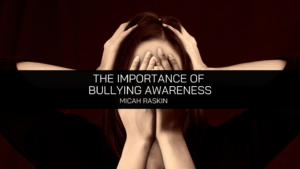Micah Raskin Speaks Out About the Importance of Bullying Awareness


According to the National Center for Education Statistics, approximately one in five K-12 children report being bullied. “That’s 20% of children in our school systems,” stresses Micah Raskin. “That’s too many. We have to work harder on awareness, education, and prevention.”
Bullying, according to the American Psychological Association, is “a type of aggressive behavior that takes place when an individual intentionally causes someone else discomforts on repeated occasions.” Bullying doesn’t just happen to children – bullying can exist at any stage of life. But this behavior is most common among school-age children – likely because of social pressure and adult repercussions later on in life. Bullying behavior can begin as young as preschool age and, if it’s left unchecked, it tends to escalate as the bully ages.
What Is Bullying? Micah Raskin Discusses the Importance of Widespread Bullying Education
“In order to prevent bullying, we first have to learn about what bullying is and how to spot it,” says Micah Raskin, anti-bullying advocate and local Queens and Nassau County, NY philanthropist.
Bullying is often thought of as a physical act, but it can also present itself as verbal and social abuse. Having a bad day or lashing out every once in a while does not a bully make. In fact, there are three guidelines to help determine and parse true bullying behavior:
- The behavior must be aggressive and unwanted to be considered “bullying”
- There must be an imbalance of position or power (i.e. popularity, physical strength, grade, socioeconomic status, etc.)
- There is a pattern of behavior or potential for a pattern of behavior to develop (i.e. it’s repeated or repeatable)
Bullying can occur just about anywhere. However, the highest concentration tends to be in spaces with a high number of children and low adult supervision. Recess, the cafeteria, in the bathroom, and on the bus are all examples of high-risk environments.
“Unfortunately,” says Micah Raskin, “now we also have to worry about cyberbullying. It’s becoming an increasing problem because it’s difficult to fully monitor your child online.” The most common online areas where cyberbullying occurs include:
- Social media (Facebook, Snapchat, etc.)
- Text messaging
- Reddit and other online forums and chat rooms
- Online gaming
With suicide rates up among young adults and children as young as twelve, it’s more important than ever to be aware of your child’s activity online. Bullying, and specifically cyberbullying, is listed as a reason for suicide in an alarming number of victims’ notes.
“Bullying hurts,” says Micah Raskin. “I know from personal experience. It makes you feel worthless and it makes you afraid. It makes your life a misery and, as a child, you feel like you’re powerless to stop it. My father taught me to stand up to bullies and eventually they left me alone. Not everyone has a man like my father. And standing up to them doesn’t always work. We have to build awareness on the adults’ end so we can recognize and address bullying in a way that puts an end to it for good.”
Why Do Bullies Bully? Micah Raskin Encourages Addressing the Root Cause of Bullying
There is no one root cause of bullying. Every child is different and has a different experience and upbringing. Sometimes, bullying indicates a lack of parental awareness and supervision. It can also be an indication of abuse or childhood trauma – children tend to lash out in ways that mirror their home life. But sometimes children simply feel a lack of power or popularity and see bullying as an opportunity to change that. Often, bullies were themselves bullied (whether at home or in school) and the cycle of abuse convinces them that becoming the bully is the only way to regain their power.
It’s tempting to label a bully as a “bad kid,” but in order to end bullying at its source and keep other children from experiencing the same negative treatment, we have to suss out and address the reasons for the behavior rather than just treating the symptoms.
Counseling – in school or out – can help children learn to recognize and channel their aggression and triggering emotions into more healthy outlets. While you cannot always change a child’s home life, you can offer safe spaces for children to express themselves and learn how to control their emotions and actions.
Sports are an excellent way to help channel aggression while encouraging healthy interaction with your peers as well as building teamwork skills. After school programs are another excellent way to offer kids a safe place away from a troubled home that is supervised by caring adults. Even if bullying behavior is not caused by abuse or trauma, having a healthy way to channel aggression and a structured environment in which to learn and grow is tremendously helpful.
Micah Raskin Lays Out the Signs Of Bullying to Watch For
“It’s easy for bullying to slip by us,” says Micah Raskin. “Adults can’t be around 24/7, and kids tend to shy away from being seen as ‘the snitch.’ So it’s important that we educate ourselves on the signs. We all assume our child is in danger of being bullied, but it’s important to watch for signs that they may be the bully as well.”
Signs that a child may be being bullied include:
- Sudden withdrawal from activities and relationships they used to enjoy
- Reluctance to go or fear of school
- A decrease in self-esteem
- Difficulty sleeping or an increase in nightmares
- Drastic changes in their behavior toward mobile devices and internet behavior. (A sudden increase can indicate feeling alone or needing reassurance and identity from online sources, and a decrease can mean they are avoiding certain apps because of cyberbullying)
- Sudden changes in friend groups/seemingly choosing to be alone
Signs that a child may be bullying others include:
- An increase in aggressive behavior
- Unexplained money or new possessions
- Lack of empathy
- Excessive desire or pressure to be popular and/or successful
- Spend time with other aggressive children
- Spends an exorbitant amount of time online
“If you see any of these signs of bullying in your child, talk to them about it,” says Micah Raskin. “Bullying is so isolating. And one of the things you tell yourself is that no one notices because no one cares. Show them you care by asking if they’re okay and if they’re being bullied.”
Micah Raskin is an anti-bullying advocate, a philanthropist, and a professional poker player from Nassau county NY. He works to fund after school programs, raise bullying awareness, and invest in the Nassau and Queens county communities that he loves.

